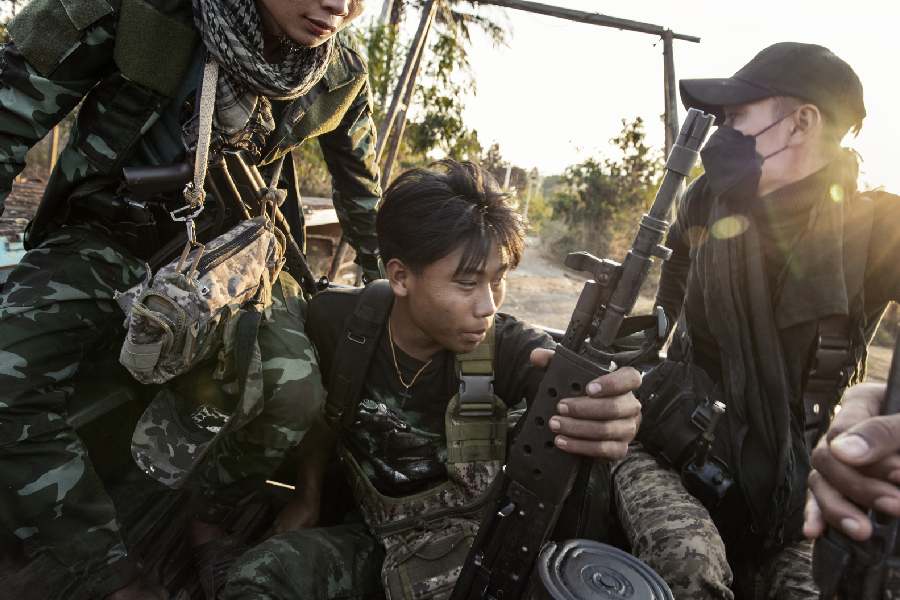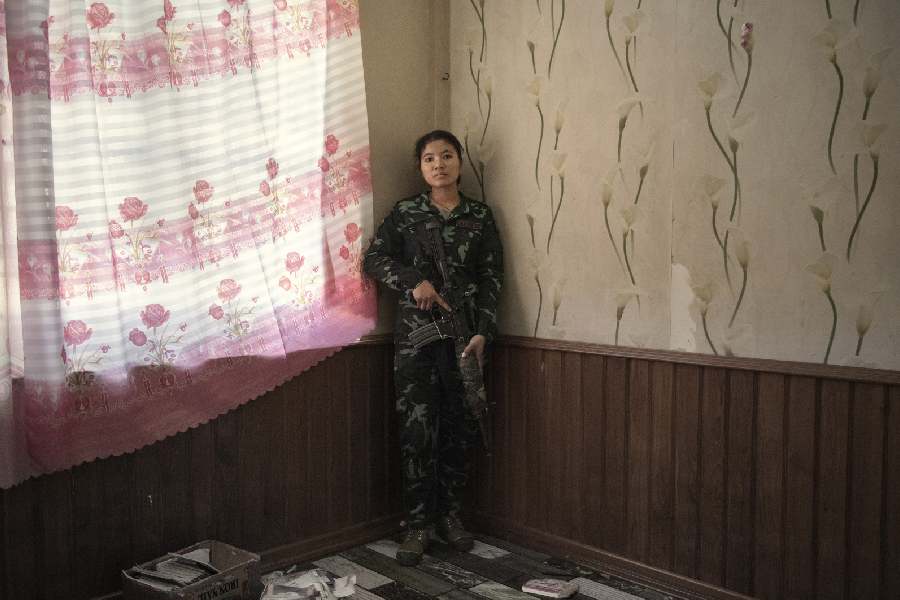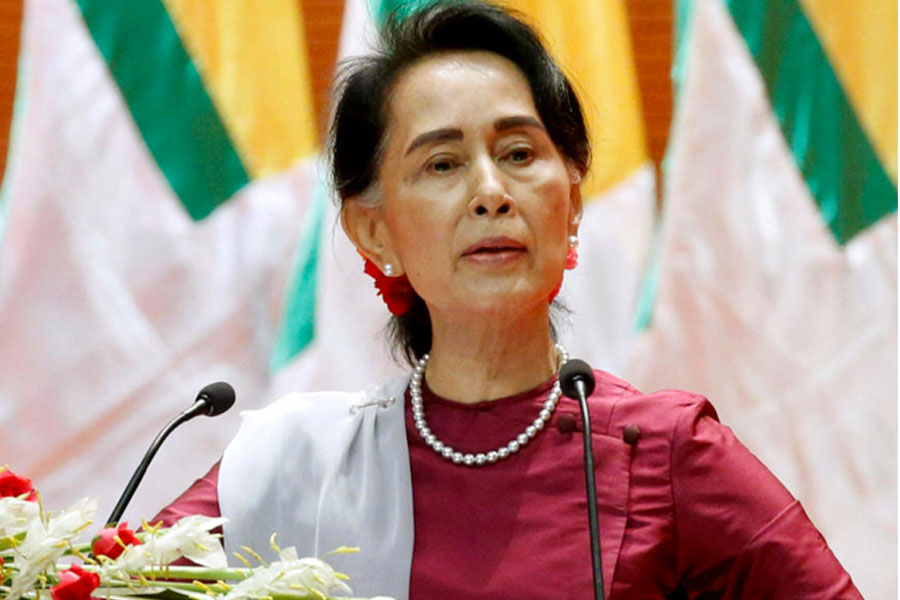The night Suu Kyi thought she would die of her wounds on the front lines of a forgotten war, a crescent moon hung overhead. A pendant of the Virgin Mary dangled around her neck. Maybe those augurs saved her. Or maybe, she said, it was not yet time for her to die.
“When I joined the revolution, I knew my chances of surviving were 50-50,” Suu Kyi, 21, said of her decision to enlist as a rebel soldier, fighting to overthrow the junta that returned Myanmar to military dictatorship three years ago. “I’m an ordinary girl, an ordinary young person. I believe in federal democracy and human rights.”
Suu Kyi said the words “federal democracy” in English. There are no easy words for the concept in Burmese.

Resistance soldiers ride in the back of a pickup truck in southern Karenni State, in Myanmar, on Jan. 28, 2024. Rebel fighters have handed Myanmar’s army defeat after defeat, for the first time raising the possibility that the military junta could be at risk of collapse. Adam Ferguson/The New York Times
Since the junta in Myanmar staged its coup in February 2021, ending a brief period of democratic reform and training its guns once again on peaceful protesters, much of the country has turned against the military. A new generation, which came of age during the civilian administration of the Nobel laureate Aung San Suu Kyi, has taken to arms, joining rebels who have opposed military dictatorship for decades.
The world’s gaze has remained focused on other conflicts on other continents — to the consternation of many in Myanmar who wonder why the chaos and death here brings little global outcry. Now, after three years of desperate resistance, the battle lines are changing fast. The rebels have overrun scores of military bases and taken over dozens of towns. The tempo of victory has quickened in recent days, and anti-junta forces now claim to control more than half of Myanmar’s territory, from lowland jungles to the foothills of the Himalayas.
Much of the fighting’s rhythm seems syncopated to that of another century: trenches dug into unrelenting mud, the slide of flip-flops down monsoon-soaked hills, the clatter of homemade AK-style assault rifles in dusty towns. The junta’s multiple rocket launchers and fighter jets may bring a modern touch to the killing, as does the hovering of the resistance’s battle drones. But this conflict, with its hand-to-hand combat and profusion of land mines, feels like a throwback to the kind of civil war that was documented in black and white.

A church damaged by the Myanmar military in southern Karenni State, in Myanmar, on Jan. 28, 2024. Adam Ferguson/The New York Times
If they manage to push into the nation’s heartland — no sure thing — the insurgents could unseat a military that has, in one form or another, kept Myanmar in its grip for more than half a century. The result may be not so much a shifting of power as a shattering of a nation, its vast periphery breaking permanently away from central control.
“We want liberation from the Myanmar army,” Suu Kyi said. “I am willing to sacrifice myself for that.”
Suu Kyi’s militia is called the Karenni Nationalities Defense Force, or KNDF. Claiming more than 8,000 soldiers, it is an umbrella organization for bands of armed youth in Karenni, Myanmar’s smallest state and the site of some of the most intense fighting. Its front-line strategist, Deputy Cmdr. Maui Phoe Thaike, is an environmentalist who studied at the University of Montana at Missoula.

Soldiers with the Karenni Nationalities Defense Force keeping a Myanmar military outpost in their sights on the front line in Loikaw, Karenni State, on Jan. 31, 2024. Adam Ferguson/The New York Times
The KNDF and its allied militias could soon control all of Karenni, making it the first state in Myanmar to break free from junta control, military analysts say. In a series of nationwide offensives starting last fall, insurgents have repelled the junta from large swaths of Myanmar’s north, west and east. This month, guerrillas captured a major trading town on the border with Thailand. Naypyitaw, the capital of Myanmar built by the junta as a defensive fortress, is fewer than 150 miles from Karenni.
Facing resistance on many fronts, the junta said in February that it was implementing conscription for all young men and women in the country. Morale has plunged, deserters from the military said, even as the bombardment of civilians has intensified.
Throughout the military’s half a century in power, various rebel forces have tried to unseat the generals. All have failed. This time, the opposition says, is different, in part because much of the country’s Bamar ethnic majority has found unity with minorities living in the border regions.

Ma Suu Kyi, a soldier with the KNDF, in Loikaw, Karenni State, on Jan. 31, 2024. Adam Ferguson/The New York Times
The young people who grew up during a period of openness, when Myanmar welcomed foreign innovations such as Facebook and KFC, chafe at how the junta has once again closed off the country. They know how much they have lost with the generals’ inward turn, and they have used social media to expose the junta’s atrocities: the imprisonment and torture of thousands of civilians, airstrikes on schools and hospitals, the killing of children with single shots to the head.
Still, it’s far from certain whether the insurgents — not to mention the 214,000 government workers who are still striking as part of a civil disobedience campaign — can maintain their resolve for a fourth year or more.
After the junta’s forces gunned down unarmed protesters in the wake of the coup, Linn Ni Zho, a medical student, fled to Karenni state and helped set up a secret hospital to treat rebel soldiers, as well as civilians maimed by land mines and airstrikes. The hospital is now the only major one operating in Karenni, as the military’s aerial bombardment, per capita, outpaces the Russian campaign in Ukraine.
“Looking for the help of the U.N., looking for the help of the international governments, is like walking in the dark,” Linn Ni Zho said. “We have to do by ourself to escape from this kind of hell.”
‘We Had Big Dreams’
In an emergency ward camouflaged with netting and leaves, served only by a forest track, Linn Ni Zho tended to the casualties of war. The tools of a jungle hospital surrounded her: saws for amputations, yards of gauze for bullet wounds and a generator to power lights for surgery.
Severing limbs pulverized by land mines or plunging her arms into chest cavities torn apart by mortars was not what Linn Ni Zho thought she would be doing when she chose to study medicine. Now 25, she grew up as Myanmar’s military rulers voluntarily began sharing power with civilians.
Before that change, possessing an unregistered cellphone or foreign currency could land a person in prison for years. Listening to BBC radio broadcasts meant risking arrest.
By the time Linn Ni Zho was in college, she was making pocket money selling La Mer and Lancôme beauty products online, sourced from a relative living in California. She downloaded American sitcoms on her phone — “Emily in Paris” is a current favorite — and considered setting up a private practice.
“All of us had big dreams, but I think they were normal dreams,” she said of her generation.
The coup three years ago began with an internet blackout and the arrests of Myanmar’s civilian Cabinet, including Aung San Suu Kyi. For a citizenry collectively hunched over phones, checking Facebook, the halt to communications came as a shock. (Today in most of Karenni, there is no phone or internet service.)
Within 20 days of the coup, the junta’s snipers had shot dead the first peaceful protester, a 20-year-old woman standing in a crowd. Since then, more than 4,800 protesters and political prisoners have been killed, and 26,500 people have been arrested, according to a tally by the Assistance Association for Political Prisoners (Burma), which uses the former name for Myanmar.
“We lost all of our lives, all of our futures, with our human rights, civil rights violated every day,” Linn Ni Zho said. “When dictatorship came, I just could not accept it as a youth.”
Linn Ni Zho escaped to Karenni, also known as Kayah, which is home to ethnic minorities who have long been persecuted. For the first time, a significant multiethnic resistance was forming.
With others from Myanmar’s Bamar-dominated cities, Linn Ni Zho set up a hospital.
But in 2022, fighter jets targeted the facility. The medics built a new hospital deep in a forest to protect against airstrikes. The staff live in huts, bunkers dug into the earth for the bombardment they believe is inevitable.
“They can destroy the buildings, but they cannot destroy our willpower,” Linn Ni Zho said.
Last November, resistance fighters rushed a soldier to the hospital: It was Suu Kyi, the young rebel with the Virgin Mary pendant, who had been wounded during the KNDF’s attempt to take Loikaw, the state capital.
Earlier in the day, she was sheltering in a shot-up building in a shot-up city, one that had emptied of 50,000 residents in a few days. Junta troops staked out a position across the street, so close that the astringent smell of the betel they chewed mixed with the fumes of war. An artillery shell detonated near Suu Kyi.
“I could not feel my body,” she said. “I thought this is what it feels like to die.”
An X-ray confirmed to Linn Ni Zho, who was on duty that day, that shrapnel had hurtled through Suu Kyi’s back and pierced her lung. All they could do was wait to see if there was serious internal bleeding.
Three months later, Suu Kyi was back on the front line in Loikaw, an assault rifle slung over her shoulder. Shrapnel remained lodged in her body. The enemy was close.
On the way to visit her, New York Times journalists passed a Buddhist pagoda balanced, golden and delicate, on a rocky outcrop. The street had once hummed with pilgrims and schoolchildren. There had been a sushi bar.
Now, the street was deserted, save the resistance fighters taking us to the abandoned house the KNDF had taken for an outpost. Spent bullets glistened on the ground. Barricades had been forsaken, metal twisted into ominous sculptures of war.
Suu Kyi was on the fourth day of a weeklong rotation. It had been a good day, she said: no artillery strikes nearby. She smiled.
But then small-arms fire cascaded from the Myanmar military’s hillside position, striking just outside the house and flashing bright in the midday sun. Suu Kyi smiled again as her fellow soldiers took aim out a window.
A cat left behind by the house’s owners meowed in alarm. Suu Kyi reached down to stroke it. Before COVID, before the coup, before the war, she was to study geography in college. She was to become a teacher. The cat brushed against Suu Kyi, threading her legs in a nervous pattern, then slinked behind sandbags.
“Maybe after we win the revolution, I can continue my life again,” she said. “Maybe not me, but people of my











